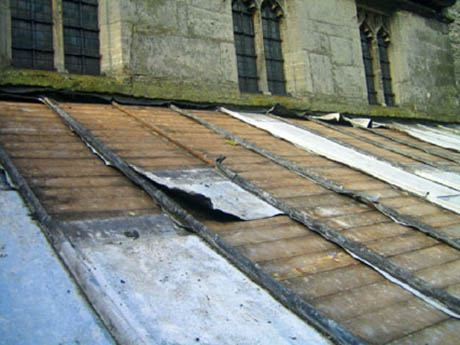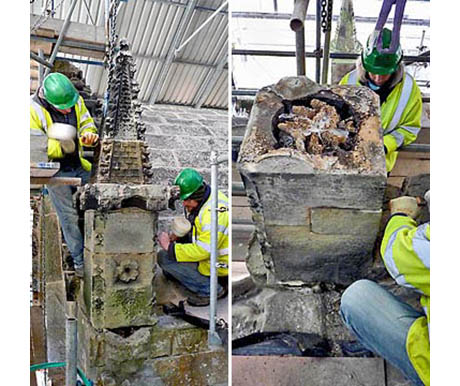A beehive is the urban roof accessory du jour, even more popular than its eco-friendly cousins, solar panels or greenery. New York City’s Waldorf Astoria hotel is only the most recent to join a trend that includes roofs from the Paris Opéra to Chicago’s City Hall, as high-end chefs, locavores, and urban homesteaders alike enjoy the taste of honey made from trees and flowers in their own neighbourhood.
Meanwhile, in the UK, rising lead prices have led to a sharp rise in churches losing their roofs to theft. A report in The Telegraph captures the scale of the problem, describing organised gangs that use Google Earth to plan raids that strip the lead from church roof after church roof:
One church was reportedly hit 14 times in 2011 alone as thieves returned again and again to take the new lead each time it was replaced. 2010 was the third worst year on record for the theft of metal from churches, with 1,484 claims costing the insurer more than £3 million.

IMAGE: A partially stripped British church roof. Photo courtesy Ecclesiastical Insurance, via English Heritage.
Curiously, you can unite these two trends with fantastic results.A church in York, the victim of repeated lead thefts, has done exactly that. In a recent letter to The Times, architect Hugh Petter explains that “the flat roofs of this historic building are now the home of bees,” and that “since the hives were installed on the church [...] there has been no further trouble.”
In what seems to be an extremely clever solution, would-be thieves are effectively dissuaded without the intrusion and expense of alarms and security guards. Meanwhile, the congregation can be kept sweet and/or future repairs subsidised through the gift or sale of holy honey.

IMAGE: The Rosslyn Chapel hives. Photo courtesy The Times, via BLDGBLOG.
Of course, it’s possible that the canny folk of York were not the
first to come up with this idea. Certainly, while reading the letter, I
was reminded
of the 2010 discovery of two stone beehives carved into a pinnacle on
the roof of Scotland’s fifteenth-century Rosslyn Chapel. The BBC reported
that the manmade hives, which the bees could enter through a hole in a
carved stone flower, had been inhabited until “a canopy was put over the
chapel during renovation works,” and that the bees would likely return
when the repairs were finished.At the time, architect Malcom Mitchell told the BBC that the hives as “unprecedented,” because they “were never intended to be a source of honey.” Instead, he speculated, the stone hives seemed to be put there “purely to protect the bees from our inclement weather.”
Scotland does indeed enjoy a climate that is frequently both wet and cold, and perhaps metal theft was not quite as pressing a concern in the middle ages. Nonetheless, with burglary deterrence to add to their gifts of honey and pollination services, sharing our roofs, religious or otherwise, with bees seems like a pretty sweet idea.
No comments:
Post a Comment